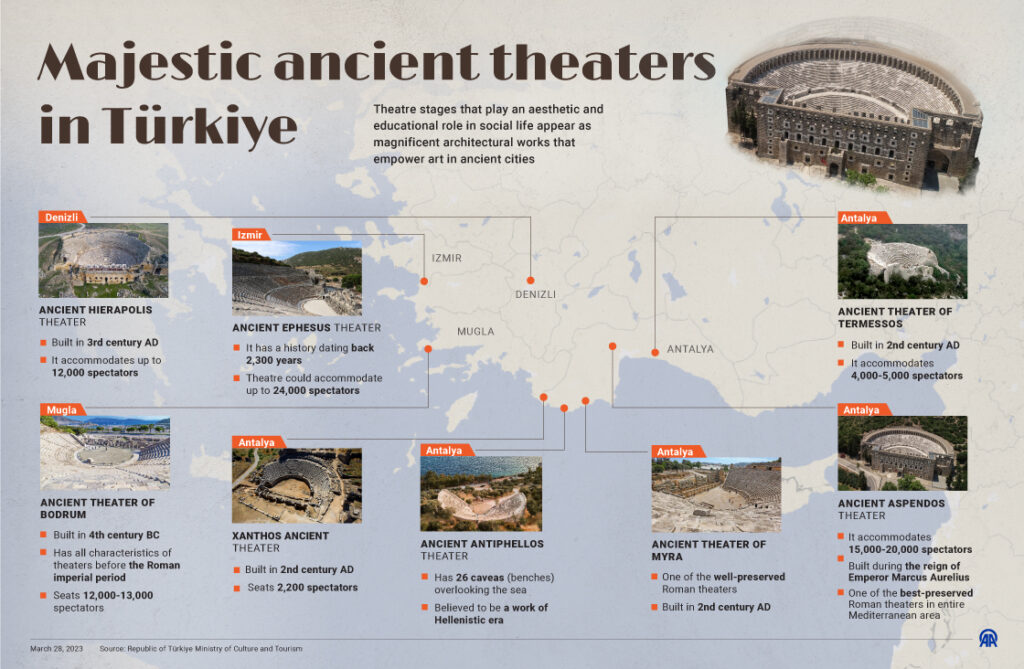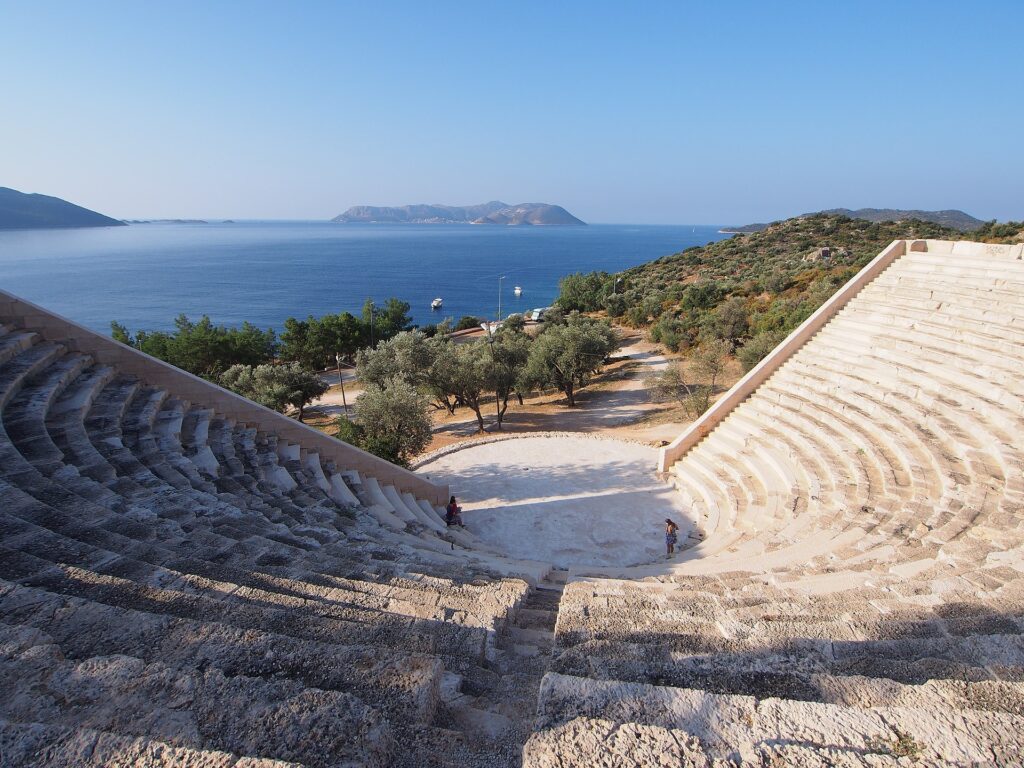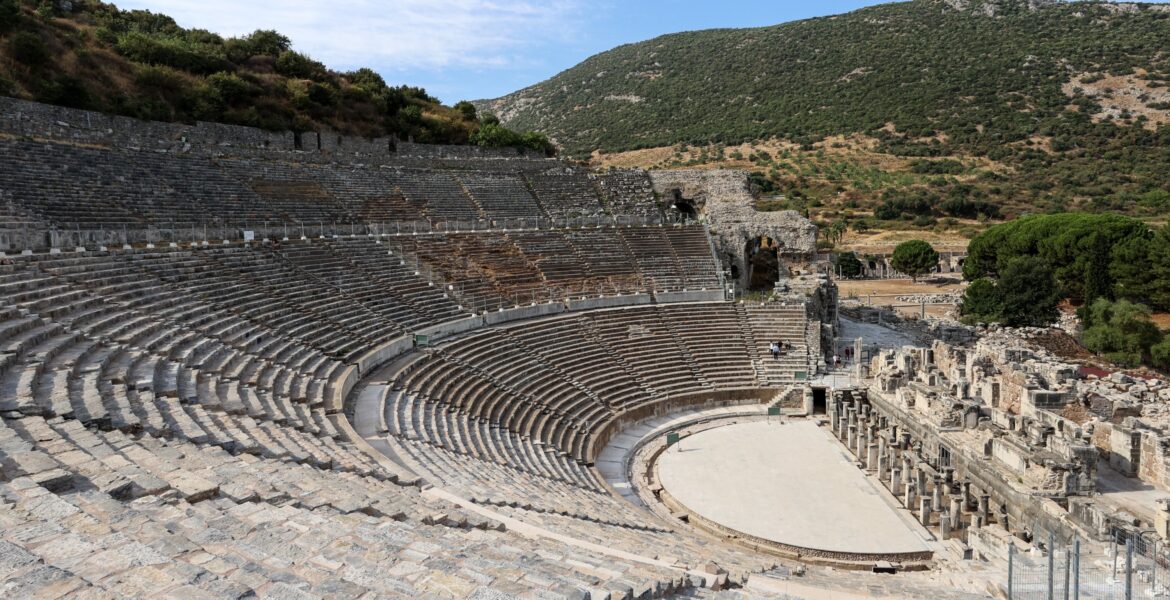Ancient theatres such as Ephesus, Aspendos, and Hierapolis in Turkey are like paradise to those who want to sail through history, says the article on the Anadolu Agency website.
• From Ephesus to Aspendos, Türkiye is a paradise for history aficionados
— Anadolu English (@anadoluagency) March 28, 2023
Majestic ancient theaters make Türkiye one of the most attractive touristic destinations for history lovers https://t.co/qrEr9nuQwJ pic.twitter.com/Rb2o7948oP
Greek City goes through the history of each theatre and adds the missing Hellenistic information.

The Ancient Ephesus Theater in the western Izmir province stands out with its splendidly preserved structure. It was first constructed in the Hellenistic Period, in the third century BC during the reign of Lysimachos.
The ancient Ephesus theatre, originally built by Greek king Lysimachus, has a history of 2,300 years so it could accommodate up to 24,000 spectators.
Only around three hours away from Ephesus, the ancient Hierapolis theatre in the western Denizli province was built in the third century AD during the reign of the Roman Empire Hadrian. Hierapolis could accommodate up to 12,000 spectators.
Ancient Greek: Ἱεράπολις, lit. "Holy City") Hierapolis was originally a Phrygian cult centre of the Anatolian mother goddess of Cybele and later a Greek city.
Turkey's western Mugla province is home to another majestic ancient theatre, Bodrum Antique Theatre. The Bodrum Antique Theatre is a beautiful example of a classical Greek theatre.
It’s a place where you can be part of an audience at a live show and retrace the footprints of ancient gladiators. It’s also a place to enjoy splendid views of Bodrum’s townscape, coastline and marina.
The amphitheatre is one of the great architectural masterpieces of the ancient Greek city of Halicarnassus, modern-day Bodrum. It dates back to the 4th century B.C. and the reign of King Mausolos.
The ancient theatre in Mugla seats around 12,000 spectators.
The theatre is a witness to the great past of Bodrum (Halicarnassus). Situated on the hillside overlooking Bodrum, this theatre, whose capacity is around 13.000, was built during the Carian reign in the Hellenistic age (330 - 30 BC).
The theatre consists of three different sections: a place for the audience, a place for an orchestra and the stage. It became an open-air museum after the excavations in 1973.
The Turkish Mediterranean resort city of Antalya is also home to ancient theatres such as Xanthos, Antiphellos, Myra, Aspendos, and Termessos.
The ancient city of Xanthos, Turkey (Xantos, Xhantos, Xanths) became famous for the heroic deeds of its people - not once they burned their city so it did not get to the enemy. This is one of the oldest cities referred to in the "Iliad" of Homer and the myth of Bellerophon.
In ancient times Xanthos was the residence of King Iobates. It was one of the most influential cities of the time and the capital of the Lycian Union.
According to ancient Greek mythology, Xanthos was founded by Sarpedon from Crete. The first official mention of Xanthos in the chronicles of the conquest of the Astyages (Median King of Lycia) dates back to 545 BC.
The Ancient Aspendos Theater was built during the reign of Emperor Marcus Aurelius.
Aspendos was an ancient Greco-Roman city. The site is located 40 km east of the modern city of Antalya.
The site is visited by approximately 400.000 people annually, mainly because of its magnificent Roman theatre. “This is not like anything that I ever saw before.”
This is how the British archaeologist David George Hogarth described the Aspendos Theatre in 1909 in a paragraph that continues as follows: “You may have seen the amphitheatres in Italy, France, Dalmatia and Africa; temples in Egypt and Greece; the palaces in Crete; you may be sated with antiquity or scornful of it. But you have not seen the theatre of Aspendos.”
It is known as one of the best-preserved Roman theatres in the Mediterranean and accommodates 15,000 and 20,000 spectators.
Myra was a Lycian, then ancient Greek, then Greco-Roman, then Byzantine Greek, then an Ottoman town in Lycia, which became the small Turkish town of Kale, another well-preserved Roman theatre built in the 2nd century AD.
In the Roman period, Myra formed a part of the Koine Greek-speaking world that rapidly embraced Christianity. One of its early Greek bishops was Saint Nicholas.
The Antiphellos Theater in Kas, Antalya, is believed to be a work of the Hellenistic era. It has 26 caveas (benches) overlooking the Mediterranean Sea.
Antiphellus or Antiphellos (Ancient Greek: Ἀντίφελλος) was a city that acted as the port of Phellus (Phellos) in Lycia. The well-preserved little Hellenistic theatre overlooking the sea is complete.

READ MORE: Andros: The best island in the world for naturalistic and cultural experiences.


